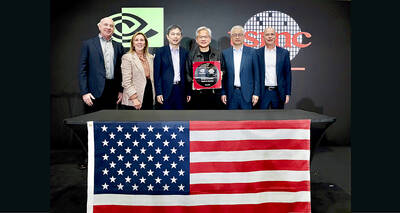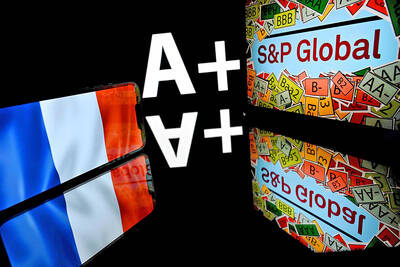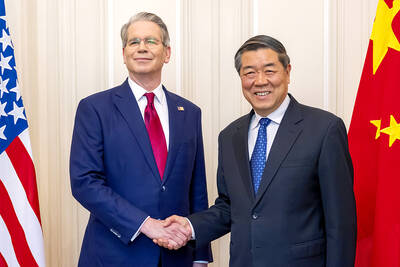Taiwan’s unemployment rate last month dropped to 3.3 percent, the lowest for the month in 25 years, as strong exports and resilient domestic demand boosted hiring across various sectors, the Directorate-General of Budget, Accounting and Statistics (DGBAS) said yesterday.
After seasonal adjustments, the jobless rate eased to 3.34 percent, the best performance in 24 years, suggesting a stable labor market, although a mild increase is expected with the graduation season from this month through August, the statistics agency said.
“Potential shocks from tariff disputes between the US and China have yet to affect Taiwan’s job market,” Census Department Deputy Director Tan Wen-ling (譚文玲) told a news conference in Taipei.

Photo: CNA
New graduates have not yet entered the labor market, but could push the unemployment rate up by 0.1 to 0.14 percent in the next three months, Tan said.
Global firms increased inventory levels after US President Donald Trump announced a 90-day delay in implementing “reciprocal” tariffs, which led to a rise in overtime hours for local manufacturers, she said.
This contributed to a decrease of 3,000 in the number of unemployed, bringing the total to 396,000, while the number of employed people rose by 6,000 to 11.61 million, the agency said.
Additionally, the number of people leaving their jobs due to dissatisfaction dropped by 2,000. the agency said, citing local firms’ hesitation to expand their payrolls, considering the high uncertainty and the short-term nature of current front-loading activities.
By demographic breakdown, the unemployment rate remained highest among those aged 20 to 24 at 11.4 percent, followed by the 15 to 19 age group at 8.94 percent, with younger people generally taking longer to solidify their career plans and secure positions.
The rate decreased progressively with age, reaching 5.56 percent for those aged 25 to 29 and 3.45 percent for the 30 to 34 age group, the DGBAS said.
Educational attainment showed mixed results. University graduates had the highest jobless rate at 4.41 percent, followed by senior-high school and vocational school graduates at 3.1 percent, it said.
Master’s degree holders had an unemployment rate of 2.88 percent, while people with junior-high school or lower education recorded the lowest unemployment rate at 1.97 percent, the agency said.
The average unemployment duration for all jobseekers was 20.3 weeks, an increase of 0.2 weeks from the previous month. However, first-time jobseekers faced a much longer job search, averaging 26.6 weeks, or 3.1 weeks longer than before.
Despite the current strength in employment figures, the DGBAS remains cautious about the job market’s outlook, saying that it is a lagging economic indicator.

Jensen Huang (黃仁勳), founder and CEO of US-based artificial intelligence chip designer Nvidia Corp and Taiwan Semiconductor Manufacturing Co (TSMC, 台積電) on Friday celebrated the first Nvidia Blackwell wafer produced on US soil. Huang visited TSMC’s advanced wafer fab in the US state of Arizona and joined the Taiwanese chipmaker’s executives to witness the efforts to “build the infrastructure that powers the world’s AI factories, right here in America,” Nvidia said in a statement. At the event, Huang joined Y.L. Wang (王英郎), vice president of operations at TSMC, in signing their names on the Blackwell wafer to

France cannot afford to ignore the third credit-rating reduction in less than a year, French Minister of Finance Roland Lescure said. “Three agencies have downgraded us and we can’t ignore this cloud,” he told Franceinfo on Saturday, speaking just hours after S&P lowered his country’s credit rating to “A+” from “AA-” in an unscheduled move. “Fundamentally, it’s an additional cloud to a weather forecast that was already pretty gray. It’s a call for lucidity and responsibility,” he said, adding that this is “a call to be serious.” The credit assessor’s move means France has lost its double-A rating at two of the

AI BOOST: Although Taiwan’s reliance on Chinese rare earth elements is limited, it could face indirect impacts from supply issues and price volatility, an economist said DBS Bank Ltd (星展銀行) has sharply raised its forecast for Taiwan’s economic growth this year to 5.6 percent, citing stronger-than-expected exports and investment linked to artificial intelligence (AI), as it said that the current momentum could peak soon. The acceleration of the global AI race has fueled a surge in Taiwan’s AI-related capital spending and exports of information and communications technology (ICT) products, which have been key drivers of growth this year. “We have revised our GDP forecast for Taiwan upward to 5.6 percent from 4 percent, an upgrade that mainly reflects stronger-than-expected AI-related exports and investment in the third

RARE EARTHS: The call between the US Treasury Secretary and his Chinese counterpart came as Washington sought to rally G7 partners in response to China’s export controls China and the US on Saturday agreed to conduct another round of trade negotiations in the coming week, as the world’s two biggest economies seek to avoid another damaging tit-for-tat tariff battle. Beijing last week announced sweeping controls on the critical rare earths industry, prompting US President Donald Trump to threaten 100 percent tariffs on imports from China in retaliation. Trump had also threatened to cancel his expected meeting with Chinese President Xi Jinping (習近平) in South Korea later this month on the sidelines of the APEC summit. In the latest indication of efforts to resolve their dispute, Chinese state media reported that